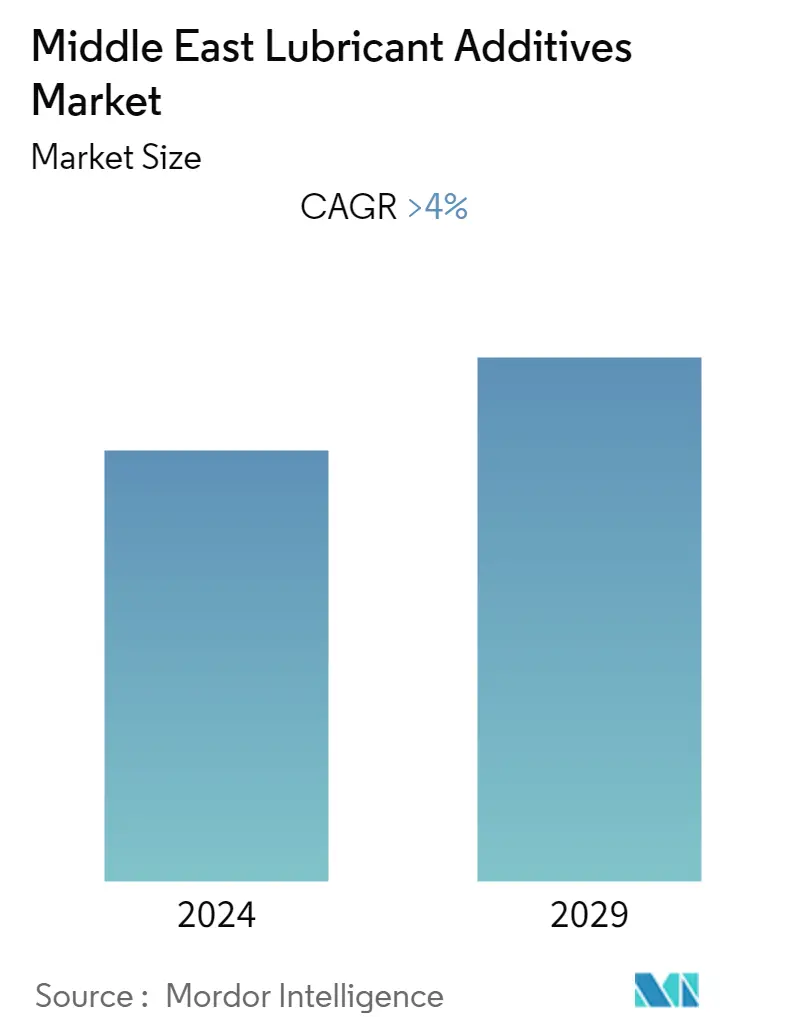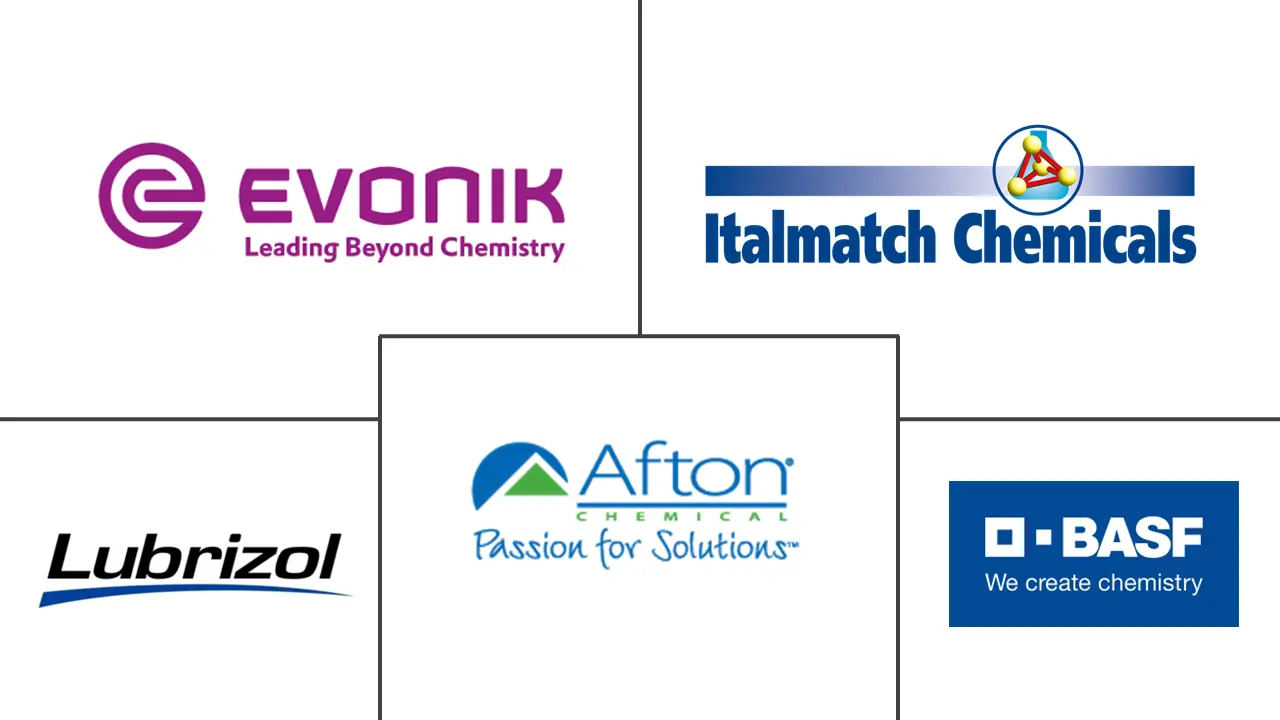Market Size of Middle East Lubricant Additives Industry

| Study Period | 2019 - 2029 |
| Base Year For Estimation | 2023 |
| Forecast Data Period | 2024 - 2029 |
| Historical Data Period | 2019 - 2022 |
| CAGR | > 4.00 % |
| Market Concentration | High |
Major Players
*Disclaimer: Major Players sorted in no particular order |
Middle East Lubricant Additives Market Analysis
The Middle-East lubricant additives market is estimated to register a CAGR of over 4% during the forecast period (2022-2027).
The outbreak of COVID-19 adversely affected the automotive and transportation industries, resulting in all-time low sales and service of both new and used vehicles. Persistent lockdowns and curfews led to disruptions in the construction and heavy equipment manufacturing industries, which effectively dropped the demand for lubricant derivatives in the market. Disruptions in the supply chain also paved the way for an overall reduction in demand and supply in the lubricant market. However, the ease of travel restrictions, rise in transportation activities, and implementation of mass vaccination programs aided the growth of this sector in 2021 in the form of elevated automobile sales. Companies in the automotive market are putting a lot of money into making cars so that they can increase their production and sales.
- A major share of demand for lubricant additives is expected from the Middle-East automotive industry. Benefitting from its strategic location and future-ready infrastructure, Dubai is perceived as the key automotive hub in the Middle East for the export of vehicles to the surrounding regions. The rising penetration of synthetic engine oil in the region is expected to be one of the major drivers within the automotive sector.
- However, supply chain disruptions and fluctuations in oil prices owing to geopolitical factors could potentially impact the supply of lubricant additives. Problems in the supply chain and logistics can cause problems like longer wait times for lubricant supplies, price changes, and less inventory.
Nevertheless, with major players mitigating the effect of supply chain disruptions with thorough inventory management, the demand and supply of lubricant additives are expected to stabilize during the forecast period. Key uses in power generation, heavy equipment, metallurgy, and metalworking are expected to further drive the demand in the next five years.
Middle East Lubricant Additives Industry Segmentation
Lubricant additives are chemical substances that, when dissolved or suspended in oils, improve the oil's functionality by generating an oil film that transforms solid friction into liquid friction, preventing heating and abrasion of metal parts. The Middle-East lubricant additives market is segmented by function, product type, end-user, and geography. By function, the market is segmented into dispersants & emulsifiers, viscosity index improvers, detergents, corrosion inhibitors, oxidation inhibitors, extreme-pressure additives, friction modifiers, and others. By product type, the market is segmented into engine oil, transmission & hydraulic fluids, metalworking fluids, general industrial oil, gear oil, grease, process oil, and other lubricant types. By end-users, the market is segmented into automotive & transportation, construction, power generation, heavy equipment, metallurgy & metal working, food & beverage, and others. The report also covers the market size and forecasts for the Middle-East lubricant additives market in four countries across the regions. For each segment, the market sizing and forecasts have been done on the basis of value (USD Million).
| Function | |
| Dispersants & Emulsifiers | |
| Viscosity Index Improvers | |
| Detergents | |
| Corrosion Inhibitors | |
| Oxidation Inhibitors | |
| Extreme-Pressure Additives | |
| Friction Modifiers | |
| Other Functions |
| Product Type | |
| Engine Oil | |
| Transmission and Hydraulic Fluid | |
| Metalworking Fluid | |
| General Industrial Oil | |
| Gear Oil | |
| Grease | |
| Process Oil | |
| Other Product Types |
| End-user Industry | |
| Automotive & Transportation | |
| Construction | |
| Power Generation | |
| Heavy Equipment | |
| Metallurgy & Metal Working | |
| Food & Beverage | |
| Other End-user Industries |
| Geography | |
| Saudi Arabia | |
| United Arab Emirates | |
| Iran | |
| Qatar | |
| Rest of Middle-East |
Middle East Lubricant Additives Market Size Summary
The Middle East lubricant additives market is poised for growth, driven primarily by the automotive and construction sectors. The region's strategic location and advanced infrastructure, particularly in Dubai, position it as a key automotive hub, facilitating vehicle exports to neighboring areas. The demand for synthetic engine oils is on the rise, spurred by the automotive industry's shift towards energy-efficient and durable materials. Despite challenges such as supply chain disruptions and geopolitical fluctuations affecting oil prices, major industry players are implementing robust inventory management strategies to stabilize the market. The construction sector, bolstered by government investments in infrastructure projects, also contributes to the increasing demand for lubricant additives.
Saudi Arabia stands out as a dominant force in the Middle East lubricant additives market, with significant consumption across automotive and construction activities. The country's efforts to establish itself as a regional automotive hub, coupled with its status as the largest auto and auto parts market in the Middle East, drive the growth of lubricant additives. While the adoption of electric vehicles is still in its nascent stages, investments in EV manufacturing abroad indicate a potential shift in demand dynamics. The market is fairly consolidated, with major players like ADNOC, TotalEnergies SE, and Exxon Mobil Corporation leading the charge. Recent expansions and product launches, such as SI Group's new aminic antioxidants and ADNOC's Voyager Green Series, highlight ongoing innovation and adaptation to market needs.
Middle East Lubricant Additives Market Size - Table of Contents
-
1. MARKET DYNAMICS
-
1.1 Drivers
-
1.1.1 Rising Synthetic Oil Penetration in the Region
-
1.1.2 Growing Automotive Sector in the Middle East
-
-
1.2 Restraints
-
1.2.1 Rising Raw Material Costs
-
1.2.2 Supply Chain Disruptions
-
-
1.3 Industry Value-Chain Analysis
-
1.4 Porter's Five Forces Analysis
-
1.4.1 Bargaining Power of Suppliers
-
1.4.2 Bargaining Power of Buyers
-
1.4.3 Threat of New Entrants
-
1.4.4 Threat of Substitute Products and Services
-
1.4.5 Degree of Competition
-
-
-
2. MARKET SEGMENTATION
-
2.1 Function
-
2.1.1 Dispersants & Emulsifiers
-
2.1.2 Viscosity Index Improvers
-
2.1.3 Detergents
-
2.1.4 Corrosion Inhibitors
-
2.1.5 Oxidation Inhibitors
-
2.1.6 Extreme-Pressure Additives
-
2.1.7 Friction Modifiers
-
2.1.8 Other Functions
-
-
2.2 Product Type
-
2.2.1 Engine Oil
-
2.2.2 Transmission and Hydraulic Fluid
-
2.2.3 Metalworking Fluid
-
2.2.4 General Industrial Oil
-
2.2.5 Gear Oil
-
2.2.6 Grease
-
2.2.7 Process Oil
-
2.2.8 Other Product Types
-
-
2.3 End-user Industry
-
2.3.1 Automotive & Transportation
-
2.3.2 Construction
-
2.3.3 Power Generation
-
2.3.4 Heavy Equipment
-
2.3.5 Metallurgy & Metal Working
-
2.3.6 Food & Beverage
-
2.3.7 Other End-user Industries
-
-
2.4 Geography
-
2.4.1 Saudi Arabia
-
2.4.2 United Arab Emirates
-
2.4.3 Iran
-
2.4.4 Qatar
-
2.4.5 Rest of Middle-East
-
-
Middle East Lubricant Additives Market Size FAQs
What is the current Middle East Lubricant Additives Market size?
The Middle East Lubricant Additives Market is projected to register a CAGR of greater than 4% during the forecast period (2024-2029)
Who are the key players in Middle East Lubricant Additives Market?
Abu Dhabi National Oil Company (ADNOC), TotalEnergies SE, ENOC Company, LANXESS, Exxon Mobil Corporation and BASF SE are the major companies operating in the Middle East Lubricant Additives Market.

